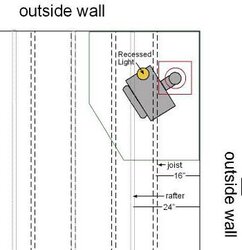We are ready to start on the flue for the new stove location. It is a 2 story installation, with a flat ceiling on the first floor. We'll be putting in a 6" flue. I'd like to have double wall in the living room, and class a from the 2nd floor through the roof (about 3 feet on 2nd floor).
The best location for the class a support box is in the first joist cavity. The first, 2nd floor joist is 16" oc from the wall. The next joist cavity over has a recessed light in the way, but I don't mind removing it if I have to. But it would mean that I would need an offset in the living room and another in the class a to avoid the roof rafter where it penetrates the roof. Not so desirable. What to do?
The 12" Duratech support box puts me right at 6 or 7 in from the wall with the double-wall pipe I think. Is this too close? Excel's system has a 10" support box which would help, but the stove shop I am working with uses DuraTech.
Would this setup work with the 12" Duratech support box? Duratech says min clearance to combustibles with their DVL pipe is 6". Is that correct? Any thoughts?
The best location for the class a support box is in the first joist cavity. The first, 2nd floor joist is 16" oc from the wall. The next joist cavity over has a recessed light in the way, but I don't mind removing it if I have to. But it would mean that I would need an offset in the living room and another in the class a to avoid the roof rafter where it penetrates the roof. Not so desirable. What to do?
The 12" Duratech support box puts me right at 6 or 7 in from the wall with the double-wall pipe I think. Is this too close? Excel's system has a 10" support box which would help, but the stove shop I am working with uses DuraTech.
Would this setup work with the 12" Duratech support box? Duratech says min clearance to combustibles with their DVL pipe is 6". Is that correct? Any thoughts?



